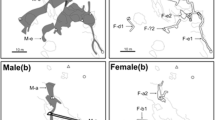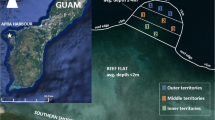Abstract
Ecological studies of boxfishes (Ostraciidae) are relatively limited, especially those related to mating systems. A few boxfishes have been shown to maintain harem polygyny, where males mate with cohabiting females within their territories; however, no other type of mating system has been reported for ostraciids. We conducted a field observational survey of Ostracion meleagris on the reefs of Kuchierabu-jima Island, Japan, focusing on home range distribution patterns and mating relationships among individuals. The spotted boxfish O. meleagris established a feeding home range on shallow reefs and migrated several hundred meters offshore most evenings, where pair spawning with high ascending behaviors (median: 7.2 m) from considerable depths (median: 8.5 m) occurred. Males began daily offshore migration earlier than females and waited for the approaches of females within their mating territories. Some territorial males maintained multiple mating opportunities each evening. Thus, the mating system of this boxfish is considered a male territory-visiting polygamy. The optimum GLMM model for explaining male mating success included the water depth of the male territory as a parameter, suggesting its importance as a factor in the mate choice of the boxfish. Their armored bodies make them less vulnerable to predation, which allows the boxfish to migrate a long way daily to spawn, using both shallow reefs suitable for foraging and offshore deeper reefs suitable for egg survival.




Similar content being viewed by others

Data availability
The datasets generated during and/or analyzed during the current study are available from the corresponding author on reasonable request.
References
Barlow GW (1981) Patterns of parental investment, dispersal and size among coral reef-fishes. Environ Biol Fish 6:65–85. https://doi.org/10.1007/BF00001801
Burnham KP, Anderson DR (2002) Model selection and multimodel inference: a practical information-theoretic approach. New York, Springer Verlag 2002:488p
Chateau O, Wantiez L (2007) Site fidelity and activity patterns of a humphead wrasse, Cheilinus undulatus (Labridae), as determined by acoustic telemetry. Environ Biol Fish 80:503–508. https://doi.org/10.1007/s10641-006-9149-6
Claydon J (2004) Spawning aggregations of coral reef fishes: characteristics, hypotheses, threats and management. Oceanogr Mar Biol Annu Rev 42:265–302
Claydon JAB, McCormick MI, Jones GP (2012) Patterns of migration between feeding and spawning sites in a coral reef surgeonfish. Coral Reefs 31:77–87. https://doi.org/10.1007/s00338-011-0821-8
Domeier ML, Colin PL (1997) Tropical reef fish spawning aggregations: defined and reviewed. Bull Mar Sci 60:698–726
Gushima K, Murakami Y (1976) The reef fish fauna of Kuchierabu offshore island of southern Japan. J Fac Fish Anim Husb, Hiroshima Univ 15:47–56. https://doi.org/10.15027/41241
Heyman WD, Kjerfve B (2008) Characterization of transient multi-species reef fish spawning aggregations at Gladden Spit, Belize. Bull Mar Sci 83:531–551
Hobson ES (1973) Diel feeding migrations in tropical reef fishes. Helgol Wiss Meeresunters 24:361–370. https://doi.org/10.1007/BF01609526
Hove JR, O’Bryan LM, Gordon MS, Webb PW, Weihs D (2001) Boxfishes (Teleostei: Ostraciidae) as a model system for fishes swimming with many fins: kinematics. J Exp Biol 204:1459–1471. https://doi.org/10.1242/jeb.204.8.1459
Humann P, Deloach N (2004) Reef fish identification: Baja to Panama. New World Publications, Florida
Johannes RE (1978) Reproductive strategies of coastal marine fishes in the tropics. Environ Biol Fish 3:65–84. https://doi.org/10.1007/BF00006309
Jones GP (1981) Spawning-site choice by female Pseudolabrus celidotus (Pisces: Labridae) and its influence on the mating system. Behav Ecol Sociobiol 8:129–142. https://doi.org/10.1007/BF00300825
Karino K, Kuwamura T, Nakashima Y, Sakai Y (2000) Predation risk and the opportunity for female mate choice in a coral reef fish. J Ethol 18:109–114. https://doi.org/10.1007/s101640070009
Kimura Y, Hibino Y, Miki R, Minetoma T, Koeda K (eds) (2017) Field guide to fishes of Kuchinoerabu-jima Island in the Osumi Group, Kagoshima, southern Japan. Kagoshima University Museum, Kagoshima
Kohda M, Sasaki K, Sakai Y, Ohnishi N, Matsumoto K (2005) Preliminary study on female choice of mates versus sites in a wrasse, Cirrhilabrus temminckii. Ichthyol Res 52:406–409. https://doi.org/10.1007/s10228-005-0292-4
Koide Y (2021) Ecological study on the spotted boxfish Ostracion meleagris (Ostraciidae) on reefs of Kuchierabu-jima Island, southern Japan. Ph.D. dissertation, Hiroshima University, Japan
Koide Y, Sakai Y (2021) Feeding habits of the white-spotted boxfish Ostracion meleagris reveal a strong preference for colonial ascidians. Ichthyol Res 68:461–470. https://doi.org/10.1007/s10228-021-00800-x
Kuwamura T (1997) The evolution of parental care and mating systems among Tanganyikan cichlids. In: Kawanabe H, Hori M, Nagoshi M (eds) Fish communities in Lake Tanganyika. Kyoto University Press, Kyoto, pp 59–86
Kuwamura T, Karino K, Nakashima Y (2000) Male morphological characteristics and mating success in a protogynous coral reef fish, Halichoeres melanurus. J Ethol 18:17–23. https://doi.org/10.1007/s101640070019
Kuwamura Tetsuo, Sunobe Tomoki, Sakai Yoichi, Kadota Tatsuru, Sawada Kota (2020) Hermaphroditism in fishes: an annotated list of species, phylogeny, and mating system. Ichthyol Res 67(3):341–360. https://doi.org/10.1007/s10228-020-00754-6
Leis JM, Moyer JT (1985) Development of eggs, larvae and pelagic juveniles of three Indo-Pacific ostraciid fishes (Tetraodontiformes): Ostracion meleagris, Lactoria fornasini and L. diaphana. Japan J Ichthyol 32:189–202. https://doi.org/10.11369/jji1950.32.189
Lobel PS (1978) Diel, lunar, and seasonal periodicity in the reproductive behaviour of the pomacanthid fish, Centropyge potteri, and some other reef fishes in Hawaii. Pac Sci 32:193–207
Lobel PS (1985) Spawning behavior of the spotted trunkfish Ostracion meleagris. Freshw Mar Aquar Mag 8:26–28
Marcroft TA (2015) Evolution of the boxfish carapace: functional consequences of shape. UCLA. ProQuest ID: Marcroft_ucla_0031N_13316. Merritt ID: ark:/13030/m5b01rx2. Retrieved from https://escholarship.org/uc/item/46x5f5k2
Mazeroll AI, Montgomery WL (1995) Structure and organization of local migrations in brown surgeonfish (Acanthurus nigrofuscus). Ethology 99:89–106. https://doi.org/10.1111/j.1439-0310.1995.tb01091.x
Mazeroll AI, Montgomery WL (1998) Daily migrations of a coral reef fish in the Red Sea (Gulf of Aqaba, Israel): initiation and orientation. Copeia 1998:893–905. https://doi.org/10.2307/1447336
Moyer JT (1979) Mating strategies and reproductive behavior of ostraciid fishes at Miyake-jima, Japan. Japan J Ichthyol 26:148–160. https://doi.org/10.11369/jji1950.26.148
Moyer JT (1984) Social organization and reproductive behavior of ostraciid fishes from Japan and the western Atlantic Ocean. J Ethol 2:85–98. https://doi.org/10.1007/BF02430572
Moyer JT, Sano M (1987) Feeding habits of two sympatric ostraciid fishes at Miyake-jima, Japan. J Ichthyol 34:108–112. https://doi.org/10.11369/jji1950.34.108
Moyer JT, Yogo Y (1982) The lek-like mating system of Halichoeres melanochir (Pisces: Labridae) at Miyake-jima, Japan. Z Tierpsychol 60:209–226. https://doi.org/10.1111/j.1439-0310.1982.tb01081.x
Myrberg AA, Montgomery WL, Fishelson L (1988) The reproductive behavior of Acanthurus nigrofuscus (Forskal) and other surgeonfishes (Fam. Acanthuridae) off Eilat, Israel (Gulf of Aqaba, Red Sea). Ethology 31:31–61. https://doi.org/10.1111/j.1439-0310.1988.tb00698.x
Nanami A, Kawabata Y, Sato T, Yamaguchi T, Kawabe R, Soyano K (2014) Spawning migration and returning behavior of white-streaked grouper Epinephelus ongus determined by acoustic telemetry. Mar Biol 161:669–680. https://doi.org/10.1007/s00227-013-2369-3
Nelson JS, Grande TC, Wilson MVH (2016) Fishes of the world, 5th edn. Wiley, New Jersey
Nemeth RS, Blondeau J, Herzlieb S, Kadison E (2007) Spatial and temporal patterns of movement and migration at spawning aggregations of red hind, Epinephelus guttatus, in the U.S. Virgin Islands Environ Biol Fish 78:365–381. https://doi.org/10.1007/s10641-006-9161-x
Parmentier E, Solagna L, Bertucci F, Fine ML, Nakae M, Compère P, Smeets S, Raick X, Lecchini D (2019) Simultaneous production of two kinds of sounds in relation with sonic mechanism in the boxfish Ostracion meleagris and O cubicus. Sci Rep 9:4962. https://doi.org/10.1038/s41598-019-41198-x
R Development Core Team. (2019). R: A language and environment for statistical computing. R Foundation for Statistical Computing, Vienna, Austria
Randall JE, Allen GR, Steene RC (1990) Fishes of the Great Barrier Reef and Coral Sea. University of Hawaii Press, Honolulu
Robertson DR (1983) On the spawning behavior and spawning cycles of eight surgeonfishes (Acanthuridae) from the Indo-Pacific. Environ Biol Fish 9:193–223. https://doi.org/10.1007/BF00692372
Robertson DR, Hoffman SG (1977) The roles of female mate choice and predation in the mating systems of some tropical labroid fishes. Z Tierpsychol 45:298–320. https://doi.org/10.1111/j.1439-0310.1977.tb02123.x
Sadovy de Mitcheson Y, Liu M (2008) Functional hermaphroditism in teleosts. Fish Fish 9:1–43
Sadovy de Mitcheson Y, Colin PL (2012) Reef fish spawning aggregations: biology, research and management. Springer, Dordrecht
Sancho G (1998) Factors regulating the height of spawning ascents in trunkfishes (Ostraciidae). J Fish Biol 50:94–103. https://doi.org/10.1111/j.1095-8649.1998.tb01020.x
Santini F, Sorenson L, Marcroft T, Dornburg A, Alfaro ME (2013) A multilocus molecular phylogeny of boxfishes (Aracanidae, Ostraciidae, Tetraodontiformes). Mol Phylogenet Evol 66:153–160. https://doi.org/10.1016/j.ympev.2012.09.022
Shapiro DY, Hensley DA, Appeldoorn RS (1988) Pelagic spawning and egg transport in coral-reef fishes: a skeptical overview. Environ Biol Fish 22:3–14. https://doi.org/10.1007/BF00000540
Shibuno T, Gushima K, Kakuda S (1993) Female spawning migrations of the protogynous wrasse Halichoeres marginatus. Japan J Ichthyol 39:357–362. https://doi.org/10.11369/jji1950.39.357
Taquet M, Diringer A (2012) Fishes of the Indian Ocean and Red Sea, Editions Quae. Versailles
Thomson DA (1969) Toxic stress secretions of the boxfish Ostracion meleagris Shaw. Copeia 1969:335–352. https://doi.org/10.2307/1442084
Thresher RE (1984) Reproduction in reef fishes. TFH Publications, New Jersey
Van Wassenbergh S, van Manen K, Marcroft TA, Alfaro ME, Stamhuis EJ (2015) Boxfish swimming paradox resolved: forces by the flow of water around the body promote maneuverability. J R Soc Interface 12:1–11. https://doi.org/10.1098/rsif.2014.1146
Warner RR (1988) Traditionality of mating-site preferences in a coral-reef fish. Nature 335:719–721. https://doi.org/10.1038/335719a0
Warner RR (1995) Large mating aggregations and daily long-distance spawning migrations in the bluehead wrasse, Thalassoma bifasciatum. Environ Biol Fish 44:337–345. https://doi.org/10.1007/BF00008248
Warner RR, Robertson DR (1978) Sexual patterns in the labroid fishes of the western Caribbean, I the wrasses (Labridae). Smithson Contrib Zool 254:1–27. https://doi.org/10.5479/si.00810282.254
Warner RR, Schultz ET (1992) Sexual selection and male characteristics in the bluehead wrasse, Thalassoma bifasciatum: mating site acquisition, mating site defense, and female choice. Evolution 46:1421–1442. https://doi.org/10.1111/j.1558-5646.1992.tb01134.x
Acknowledgements
We thank the residents of Kuchierabu-jima Island for allowing us to perform the field survey. We also thank colleagues at the Laboratory of Biology of Aquatic Resources, Hiroshima University, for their support in this study. We also thank Dr. J. Shibata for helpful comments on the manuscript. We would like to thank Editage (www.editage.com) for English language editing.
Funding
This study was funded by the Sasakawa Scientific Research Grant from the Japan Science Society and the Japan Society for the Promotion of Science KAKENHI, Grant Number 18K06419.
Author information
Authors and Affiliations
Contributions
Yuki Koide and Yoichi Sakai contributed to the conception and design of the study. Data collection and analyses were performed by Yuki Koide. The first draft of the manuscript was written by Yuki Koide, and the authors commented on the previous versions of the manuscript. Both authors read and approved the final manuscript.
Corresponding author
Ethics declarations
Ethics approval
All procedures performed in this study followed the Guidelines for the Proper Conduct of Animal Experiments outlined by the Hiroshima University Animal Research Committee (No. 020A170410 certified on April 10th, 2017), Guidelines for the Use of Animals in Research of the Association for the Study of Animal Behaviour and the Animal Behavior Society (https://doi.org/10.1016/j.anbehav.2019.11.002) the Guidelines for the Use of Fishes in Research by the Ichthyological Society of Japan (http://www.fish isj.jp/english/guidelines.html), and the Guidelines for Ethological Studies by the Japan Ethological Society (http://www.ethology.jp/guideline.pdf).
Competing interests
The authors declare no competing interests.
Additional information
Publisher's note
Springer Nature remains neutral with regard to jurisdictional claims in published maps and institutional affiliations.
Supplementary Information
Below is the link to the electronic supplementary material.
Supplementary file1 (MP4 126260 KB)
Supplementary file2 (MP4 22277 KB)
Rights and permissions
Springer Nature or its licensor holds exclusive rights to this article under a publishing agreement with the author(s) or other rightsholder(s); author self-archiving of the accepted manuscript version of this article is solely governed by the terms of such publishing agreement and applicable law.
About this article
Cite this article
Koide, Y., Sakai, Y. Male territory-visiting polygamy of the white-spotted boxfish Ostracion meleagris (Ostraciidae) involving daily spawning migration. Environ Biol Fish 105, 1165–1178 (2022). https://doi.org/10.1007/s10641-022-01330-9
Received:
Accepted:
Published:
Issue Date:
DOI: https://doi.org/10.1007/s10641-022-01330-9



